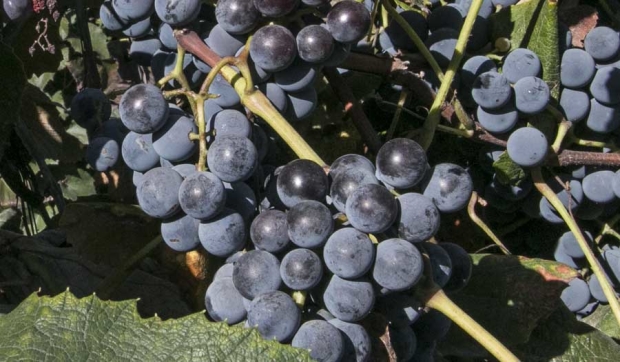
Concord grapes near Outlook, Washington. (TJ Mullinax/Good Fruit Grower)
A continued stockpile of juice and juice concentrate means growers can likely expect low prices again in 2016, but 2017 could prove to be brighter as that supply works its way onto the market.
In 2014, U.S. growers produced their largest Concord crop since 2007 at 505,180 tons, a 12 percent increase from 2013.
Washington, the largest producer, saw a 60 percent increase, harvesting 260,000 tons of Concord grapes.
The resulting supply of juice and juice concentrate is depressing prices nationally and could result in a continued decline in acreage next year, according to Dr. Trent Ball, a partner in Agri-Business Consultants LLC and director of the viticulture and enology program at Yakima Valley Community College.
Washington now has an estimated 19,300 acres — the lowest since 1978 — and could have fewer than 18,000 acres in 2016, Ball reported at the Washington State Grape Society’s annual meeting in Grandview in November.
Cash price per ton of Concord grapes remains at $110, the same as in 2014 but down from $225 per ton in 2013, and growers are at the breaking point, Ball said. “They are just covering variable costs. They are in survival mode, but they cannot operate at that price point long term and be sustainable.”
Growers have seen up-down cycles before, but even with a high yield in 2016, production won’t be as high as in previous years because so many acres have come out of the ground, Ball said. “That’s why I’m optimistic that it will start to turn around, because the adjustment is already taking place. Unfortunately, it just takes time to move out the inventory that already exists. And every processor has inventory.”
Record Brix
Following a mild winter, growers experienced the highest number of growing degree days on record during the 2015 growing season.
Harvest started and ended early, and fruit had the highest Brix level on record with small berries, good color and low acids.
The Concord crop was below average of the past 10 years, coming in at 164,000 tons. Growers harvested an estimated 11,670 tons of white Niagara grapes, which comprise just 10 percent of Washington’s juice grape crop, on about 1,500 acres.
In Michigan, growers experienced no harsh freezes and harvested a slightly above average crop.
In New York, the crop size was 90 percent of the long-term average. Yield per acre also was down, with one-third of Concord vineyards seeing significant bud damage due to a winter freeze.
Growers in Washington’s Yakima Valley who get irrigation water from the Roza Irrigation District saw their water supply shut off for three weeks due to drought.
Because the value of Concords is so low right now, growers who have other crops tended to water higher-value crops first. As a result, yields were down a bit, but sugars were sky high, said Keith Oliver, production manager for Olsen Brothers Inc. in Prosser.
“Concords are pretty low on the priority list — like last,” said Oliver, who noted that Olsen Brothers pulled out 40 acres of organic Concords in the fall. “Everything else is worth more than Concords, and money talks.”
Juice imports
Washington’s Concord grape juice production averaged 195,273 tons from 2004 to 2014. For 2015, Washington production is estimated at 164,078 tons, compared with 111,000 tons for New York, the nation’s second-largest producer.
The price for juice concentrate remains low, at an estimated $8 per gallon for concentrate produced in Washington compared with $10 per gallon for concentrate in the eastern United States. The reduced price in the West can be attributed to transportation costs, Ball said.
The U.S. continues to import a significant amount of white grape juice concentrate, Ball said, which is resulting in the removal of grape acreage in California. Some 20,000 acres were removed in 2014 — many for almonds.
Another 40,000 acres could be removed going into 2016, Ball said. However, the amount of overall imports is declining, with 33 million gallons imported in 2015, down from 40 million gallons last year and 45 million gallons in 2013. Argentina accounts for more than 80 percent of the import volume.
“The reality is we’re seeing fewer and fewer imports coming in, because the juice market is so soft,” he said.
In addition, juice exports are at a 28-year low — about 9.3 million gallons in single-strength form in 2014-2015. Canada, Japan, South Korea, China and Costa Rica represent the top five U.S. export markets, but over the past two years, each of those countries has seen a decline in U.S. exports.
Drink more juice
A study by the Produce for Better Health Foundation shows that juice consumption by U.S. consumers declined 14 percent from 2004 to 2014.
Broken down by fruit, the number of times consumers drink juice each year bears that out: seven times for Concord juice, nine times for berry juice, 16 times for apple juice and 51 times for orange juice. The trend is consistently down across the board, Ball said.
Juice has been caught up in the nationwide push for healthier menus in schools and healthier diets with less extra sugar, and it’s just not moving in the marketplace, Ball said.
But, he added, studies also show that those who consume juice actually eat more fruits, eat more vegetables and have a healthier lifestyle. “The theme is, ‘We need to drink more juice,’” he said. “Tell your friends, it’s good for you.” •
– by Shannon Dininny






Leave A Comment